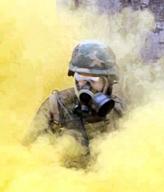




|
Chemical Weapon Information |
|
Analysing the social and ethical implications of military development |
|
Military Technology Out of Control? |



|
What are Chemical Weapons? Chemical weapons harm intended targets by its toxicity, as opposed to explosions due to a chemical reaction. Classes of Chemical Weapons 1. Nerve Gases - The deadliest of the chemical weapons. Nerve gases are available for tactical field use in a broad array of cannons, shells, and projectiles. 2. Blister Agents/Vesicants - Local action results in conjunctivitis or inflammation of the eyes, erythema followed by blistering or ulceration, inflammation of nose, throat, trachea, bronchi and lung tissue. 3. Blood Agents - A chemical compound that acts quickly by travelling through the blood streams. 4. Incapacitating Agents - Unlike the lethal agents, incapacitants can produce purely temporary effects with no long term damage. The agents either produce temporary paralysis or mental aberration. 5. Vomiting gases/Lachrymators - Produces a strong irritation in the upper respiratory tract with irritation of the eyes. 6. Incendiaries - Causes maximum fire damage on flammable materials. Also known as flame weapons. 7. Pulmonary - Act by irritating the lower reaches of the respiratory system. Destroys delicate membranes of the lungs or respiratory passages. Employment of Chemical Weapons According to FM3-10, lethal agents should be used against: · Targets containing predominantly dug-in troops · Fortified Positions · Occupied large area targets The problem Similar to all other weapons, chemical weapons cannot distinguish targets from civilians. After-effects can last for generations, with a likeness to that of any other chemical disaster. Nerve agent VX may be absorbed by vegetation and remain lethal without any knowledge. For strong nerve agents such as Sarin (GB), a lethal dose can be as little as 1mg. Most importantly, materials needed to create a chemical weapon are readily available in the form of consumer goods. Facts · The effects of vapour are enhanced when used within an enclosed space. · Nerve agents can kill in less than a minute · The nature of chemical weapons are both lethal and non-lethal. · Chemical weapons have been used not only by the military but as well as terrorist groups. · The Russian Federation possesses approximately 40,000 tonnes of chemical warfare whilst the US stockpile contains over 30,000 tonnes. |